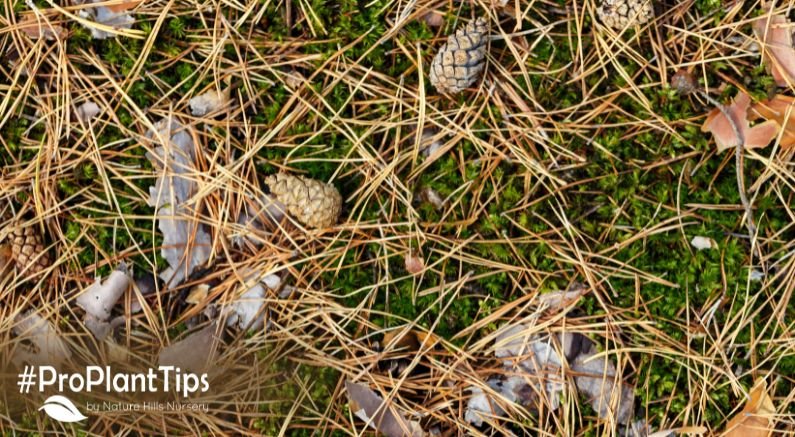
Pine Trees lose their needles ... and that’s a good thing!
Pine needles make amazing mulch, and fall needle drop is perfectly normal in the spring or fall. Each autumn, we receive a wave of concerned gardeners asking why their Pine trees are losing needles.
But here’s the truth: evergreen doesn’t mean forever-green. While Pines hold their needles year-round, they don’t keep the same needles forever. A natural win for acid-loving plants!
Pine Needles = Fantastic, Free Mulch

Pine needle mulch (also known as Pine Needle Straw) doesn’t just work hard, it looks great, too! Its soft, reddish-brown color adds a warm, natural finish to garden beds and borders. The fine texture of pine straw lies neatly and weaves together, creating a tidy, polished appearance that blends beautifully with woodland, cottage, and native garden styles. Over time, it settles into a dense mat that stays in place and enhances the landscape with a clean, well-maintained look.
Don’t rake those needles to the curb! Needle Mulch makes excellent mulch, especially for plants that love acidic soil. They're lightweight, break down slowly, and help:
- Suppress weeds
- Retain moisture
- Insulate roots
- Gradually acidify the soil
Spread the Pine Mulch 2-4 inches thick around your garden beds, but keep it a few inches away from stems and trunks to avoid rot.
Which Plants Benefit from Pine Needle Mulch?
Acidifying evergreen needle mulch isn’t just mulch, it’s a gift to many beloved garden plants that prefer slightly acidic soils. Use it around:
Shrubs:
- Azaleas
- Rhododendrons
- Camellias
- Hydrangea macrophylla (Bigleaf Hydrangeas)
- Mountain Laurel
Trees:
- Dogwood
- Magnolia
- Pine
- Spruce
- Fir
Perennials:
- Hostas
- Ferns
- Astilbe
- Bleeding Heart
- Lungwort
By repurposing your fallen Pine needles, you’re not only improving soil health but also supporting the needs of your acid-loving plants. Nature knows best, put those needles to good use!

Pine Cones: More Than Just Forest Floor Decor
Pine cones aren’t just pretty … they’re practical! These natural treasures have a variety of uses in the garden and beyond:
In the Garden:
- Mulch for containers: Use Pine cones as a top layer in potted plants to help retain moisture and reduce soil splash.
- Cat deterrent: Scatter Pine cones in garden beds to discourage neighborhood cats from using them as a litter box. The texture is uninviting to sensitive paws.
- Weed blocker: A layer of Pine cones can help prevent weeds in hard-to-mulch areas.
Around the Home:
- Decor & crafts: Use Pine cones in wreaths, centerpieces, garlands, or holiday decorations. They’re beautiful, long-lasting, and cost nothing if you collect them from your own yard!
- Fire starters: Dried Pine cones can be used as kindling in wood stoves or fire pits.
They may fall with the needles, but don’t toss them … Pine cones are just as useful!
Out With The Old: Natural Needle Drop: What to Expect
Let’s take the Eastern White Pine as an example. This tree keeps its current year's needles (the new ones at the tips) and sheds the older, two- or three-year-old needles every fall. This natural process happens fast, sometimes over just a few weeks.
What’s normal:
- Yellowing and dropping of interior needles
- The tips of the branches stay green and healthy
What’s not normal:
- Browning at the tips or widespread loss of new growth
This isn’t just a Pine thing. Spruce, Fir, and Arborvitae also shed older foliage. In Arborvitae, this often causes a flush of yellowing interior leaves that drop suddenly, triggering plenty of calls from confused gardeners. But if your evergreens have healthy green tips, there’s nothing to worry about.
Fall Watering is Key For Evergreen Health
To keep all evergreens strong through winter, help them resist freezing temperatures, and drying northern winds that cause windburn, fall watering is crucial:
- Continue watering deeply until the ground freezes
- Focus on newly planted trees and shrubs, which are still establishing roots
This simple step prevents winter burn and boosts survival rates for everything planted earlier in the year.
Garden Smarter With What Ma Nature Gives You

This blog covered why Pine trees drop their needles in fall (and why that’s normal!), how to use Pine Straw as mulch, the many ways Pine cones can benefit your garden and home, and the importance of watering evergreens through fall. We also listed many shrubs, trees, and perennials that thrive with slightly acidic soils enhanced by Pine needle mulch.
So the next time your Pine tree starts shedding, don’t see it as a mess, see it as a gift! From mulch to moisture retention, cat deterrent to crafting, Ma Nature hands you everything you need, right at your feet. All you have to do is use it!
Don't have a use for your free Pine Mulch? Go ahead and leave it beneath the tree! It will keep your Pines roots cool, discourage weeds, and retain soil moisture just as nature intended!
Happy Planting!


